ABOUT VINES
Vines, also referred to as trailing or climbing plants, seem to have the most exciting life compared to other plants. They get to climb high and reach that sunshine while also getting great views. From a human perspective, they can get a little unwieldy as they can climb onto seemingly anything with a strong grip.
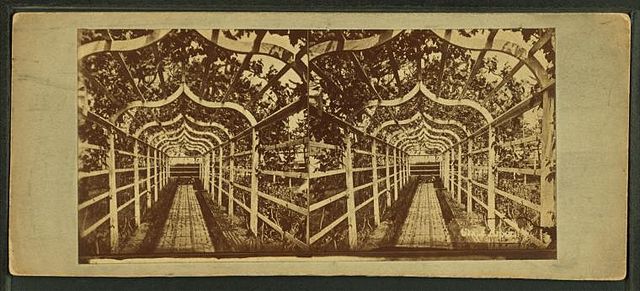
Source: Wikimedia Commons
FRUITING VINES
The primary fruiting vines that POP likes to grow are: hardy kiwi (Actinidia arguta), grapes (Vitis vinifera), maypops (Passiflora incarnata), and American hops (Humulus lupulus). These vines grow in our climate and produce lovely fruit for us to eat. Certain vines, especially maypops and hops, can take over a growing space, so it is recommended to plant those in pots or raised beds if possible.
WHY PRUNE VINES?
Why
Vines, just like fruit trees and shrubs, should be pruned every year to promote better fruit production and reduce pests and diseases. Vines produce fruit on first year wood, so any wood that left over from the previous growing season is just taking up space and reducing the amount of space for new growth. Vines also grow fast and persistently; if left unattended, they can become unruly, and fruiting will be poor due to overproduction of vegetation. Pruning keeps the plant in check. Proper training of vines is essential in maintaining the plant size, shape and productivity.
HOW TO PRUNE VINES
Pruning should occur in late winter, along with the rest of your orchard plants. This is to ensure that no flower and fruit buds, which will appear in early spring on new wood, are removed. Vines store their energy in their roots and usually fruit on new, first year wood. This is why, unlike fruit trees, which only allows for removing 30% of any live wood from the entire tree, up to 90% of a vine can be pruned back. Doing this is beneficial to the plant for our purposes in encouraging vigorous regrowth and increased fruit production. It is important that the plant has a good structure to grow onto, whether that be a fence, trellis, arbor, or pergola (like a bigger version of an arbor).
In the first two years, it is important to determine what training system to use and the vine accordingly. The form to prune towards can vary slightly from species to species, so the specific of each species will be covered below. With all fruiting vines, however, there should be one main trunk growing from the ground and up the trellis. From there it typically separates into two horizontal branches (cordons) growing in opposite directions. However, there are other forms as well. It often depends on the vine species and structure it is growing on.
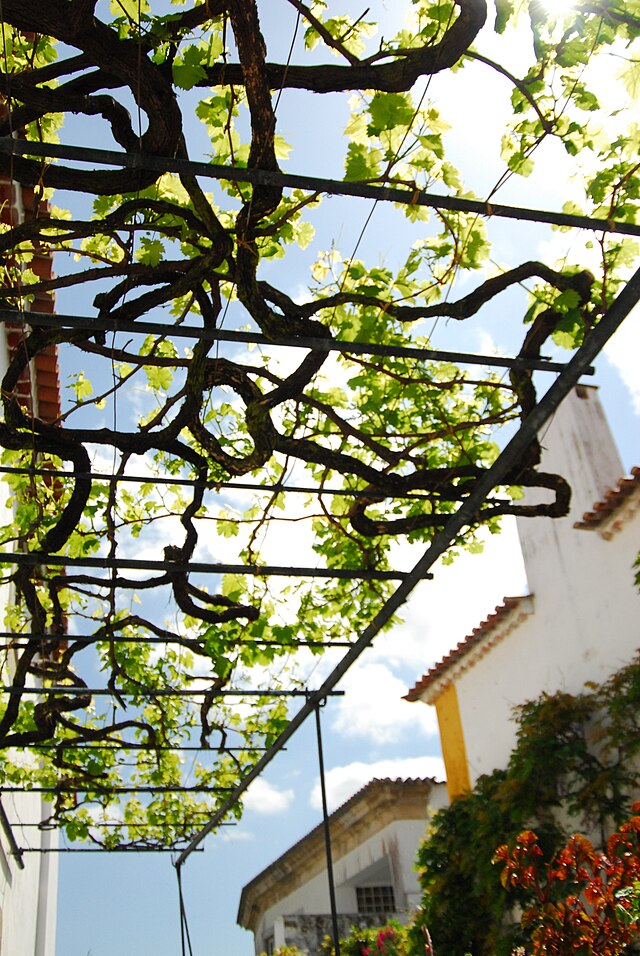
Source: Wikimedia Commons
TRAINING SYSTEMS FOR PRUNING
Training systems are methods of vine training, which can vary depending on the species, region, and preference of the grower. Each training system has its own suitable trellis system. There are many different training systems, which are not mentioned in this blog. The systems that are explained below are the ones POP typically employs at our urban orchards: the single/double cordon system and occasionally the fan system.
Single/Double Cordon System
In this system, there will be the main trunk. This is to not be pruned, unless damaged, which will require cutting it at base and starting over. For the single cordon form, one main branch, called a cordon, will grow out horizontally from the top of the trunk. For the double cordon form, two main branches, called cordons, grow out of the top of the trunk forming the “Y” structure. Along the cordons will emerge fruiting laterals, which grow out at a 90º angle from the cordon. These will bear fruit for two to three years and grow vigorously. The laterals should be draped over the outer wires every 10-15 inches. They need to be pruned when no longer productive. Leave sufficient numbers to replace old fruit canes.
If going for four cordons, two will grow out on each side of the trunk, approximately halfway up, with the top two cordons emerging from the top of the trunk.
Fan System
Fan training is one of the oldest training methods. It is ideal for vines growing along a wall or fence. It is considered inferior to the stricter cordon training forms, because fans can become messy and unmanageable.
Fan trained vines typically have a single vertical trunk with many cordon radiating out from a single base at the top of the trunk.
PRUNING GRAPEVINES
Pruning grapevines is typically done in a double cordon form, with 2-4 cordons on a trellis with two horizontal wires, one around 1 foot off the ground and another a few feet off the ground.
FIRST YEAR
- For the first year, you should focus on a strong and vertical trunk. Tie the trunk loosely to the post and keep it growing straight upward. Don’t allow it to twirl around the post. Remove all side branches until the vine reaches the top of the post. Cut out the top of the vine a few inches below the top of the post and encourage side shoots that grow laterally along the wires.
- Make sure to have an appropriate structure for a grapevine. An overhead arbor, a pergola, a trellis with horizontal wires, or an existing fence are all good options.
SECOND YEAR AND SO ON
- Prune out any dead, diseased, or damaged wood.
- Remove any suckers.
- Prune the grapevine to a double cordon form.
- Remove any side growth on trunk below the two main horizontal side branches called cordons.
- Create a single trunk and 2 semi-permanent horizontal cordons.
- Coming off the cordons are fruiting laterals, which is where the fruit buds are located. The fruiting laterals are thinned so they are approximately 6″ apart and 2-3 buds long. Keep the healthier and thicker fruiting laterals when choosing which ones to keep.
- Make sure to secure the cordons to a structure.
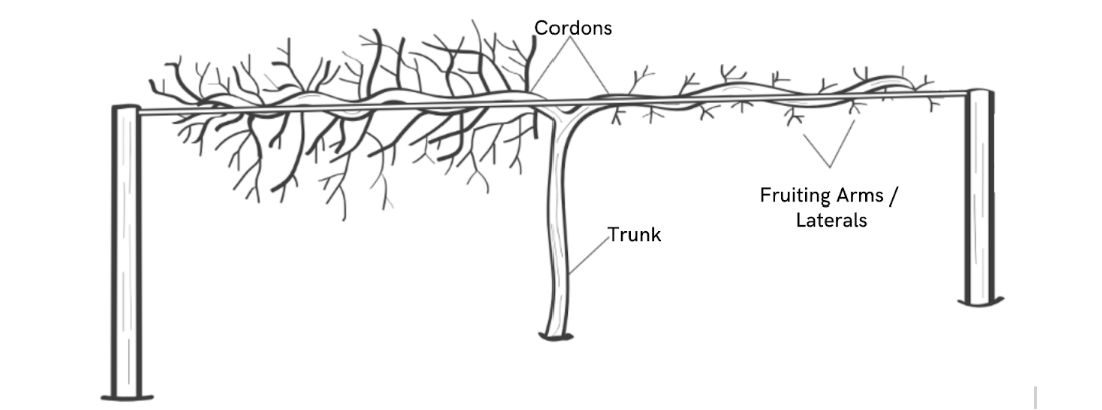
Source: POP
PRUNING HARDY KIWI
Pruning hardy kiwi is very similar to grapevine. The major difference is that hardy kiwis can fruit on first year, second year, and even third year wood. Something to note is that hardy kiwi grows more aggressively than grapevines, so should definitely be pruned with a heavy hand.
FIRST YEAR
- Make sure to have an appropriate structure for a hardy kiwi. An overhead arbor, pergola, or a strong trellis with horizontal wires are all good options.
- For the first year, you should focus on a strong and vertical trunk. Tie the trunk loosely to the post and keep it growing straight upward. Don’t allow it to twirl around the post. Remove all side branches until the vine reaches the top of the post. Cut out the top of the vine a few inches below the top of the post and encourage side shoots that grow laterally along the wires.
SECOND YEAR AND SO ON
- Prune out any dead, diseased, or damaged wood.
- Remove any suckers.
- Prune the hardy kiwi to a single or double cordon form.
- Remove any side growth on trunk below the two main horizontal side branches called cordons.
- Create a single trunk and 2 semi-permanent horizontal cordons.
- Coming off the cordons are fruiting laterals, which is where the fruit buds are located. The fruiting laterals are thinned so they are approximately 12″ apart and 6″ long. Keep the healthier and thicker fruiting laterals when choosing which ones to keep.
- Make sure to secure the cordons to a structure.
- Additional summer pruning is needed to keep these vigorous vines under control.
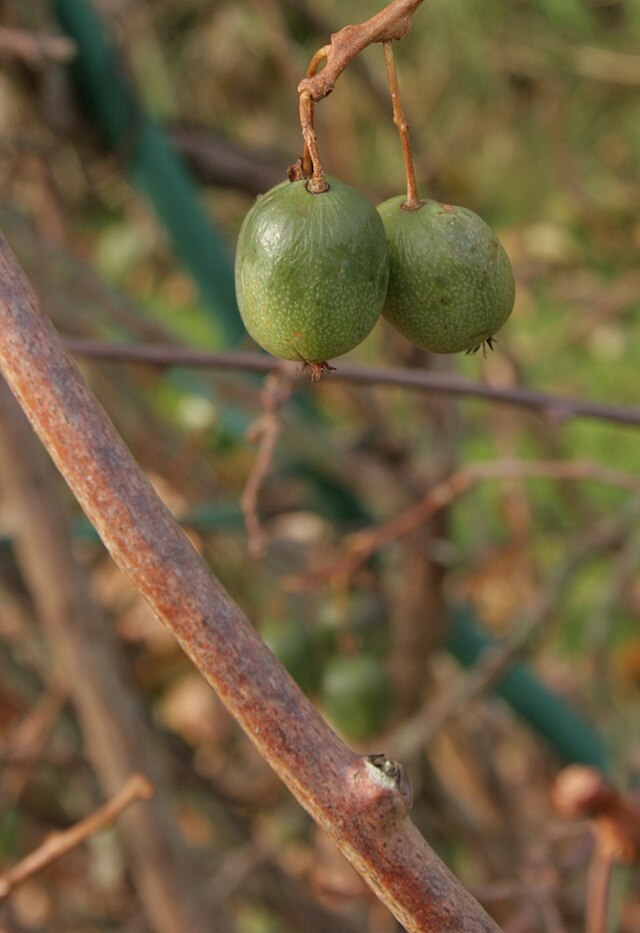
Source: Wikimedia Commons
PRUNING MAYPOPS
Maypops are an herbaceous vine, unlike the woody grapevine and hardy kiwi. It is recommended to grow maypops in a pot, since they tend to grow aggressively and are beginning to invade natural areas in the region. You need to select a very large pot, preferably 2 feet wide. The pot needs drain holes, but these should not come in contact with the ground if the pot is resting on soil, because there is a chance otherwise, its roots will find their way out of those drain holes and then escape into the native soil. This is all to say that pruning is not a huge endeavor with this one, since it will inevitably grow smaller if growing out of a pot. Because they are an herbaceous vine, they die back every year and the entire above ground vine can be cut and removed in winter.
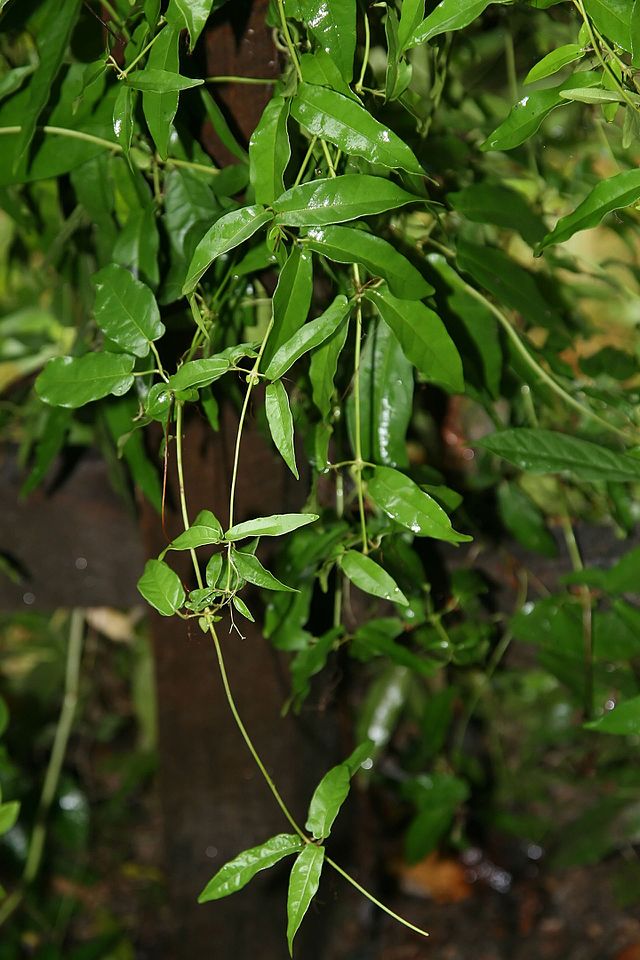
Source: Wikimedia Commons
PRUNING AMERICAN HOPS
American hops are similar to maypops in that they are a herbaceous vine. This means they also die back every year.
- Plant them in a pot or have them grow along a fence.
- Because they are herbaceous vines, they can be entirely pruned to the ground in winter.
- They can be pruned additionally in the summer after fruiting if out of control.
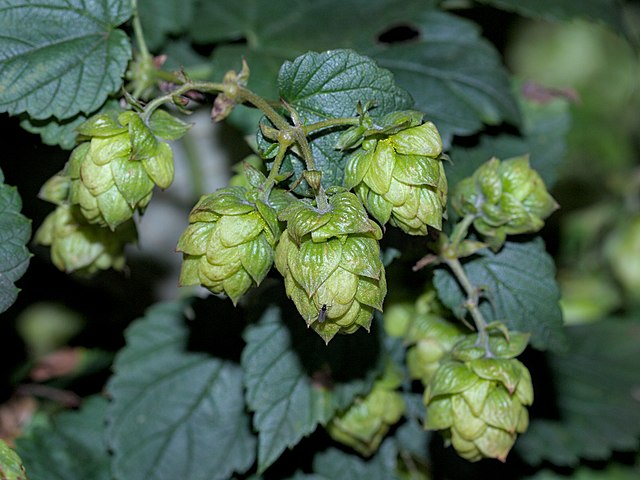
Source: Wikimedia Commons
SOURCES
Home Fruit Production: Grape Training Systems | MU Extension
Don’t be timid when pruning grapes | OSU Extension Service)
Plant Spotlight: Passionate about Passionflowers?
DISCLAIMER
The information presented on this website is for informational, reference, and educational purposes only and should not be interpreted as a substitute for diagnosis and treatment by a health care professional. Always consult a healthcare professional or medical doctor when suffering from any health ailment, disease, illness, or injury, or before attempting any traditional or folk remedies. Keep all plants away from children. As with any natural product, they can be toxic if misused.
This POP Blog was written by Orchard Assistant Simone Shemshedini with help from Co-Executive Director Phil Forsyth.
SUPPORT US! If you found this entry useful, informative, or inspiring, please consider a donation of any size to help POP in planting and supporting community orchards in Philadelphia: phillyorchards.org/donate